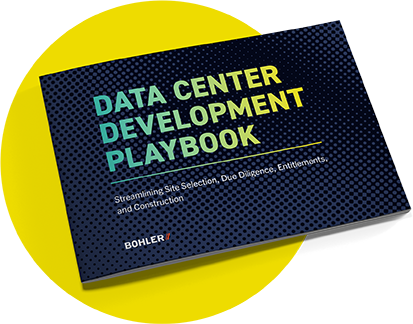Stay in the Know
Get our insights and latest news straight to your inbox.
Demand for data centers is growing by leaps and bounds. Construction in the U.S. is expected to reach $25 billion by 2027, with approximately 2,825 megawatts of power capacity added over the next five years (source).
But for those seeking to capitalize on the boom, this growth has a downside. Desirable sites are scarce, forcing developers to look beyond the obvious for suitable locations and deal with delays caused by a range of issues that go hand-in-hand with imperfect sites.
Given the situation, streamlining development requires in-depth knowledge of data center challenges, and developers need insights for addressing them creatively.
Based on my experience, here’s a topline of what you need to know to effectively navigate the new realities of the data center market.

With no easy sites remaining, every prospective site requires even more careful vetting. This means that being proactive and strategic about site selection and land planning is non-negotiable – it’s the single most critical factor to preventing a host of challenges down the road.
For example, the utility-intensive nature of data centers requires sites to support power, communication, and water needs – all of which must be considered from the start.
See Related: Due Diligence Time Crunch
Additionally, it’s vital that developers account for anything out of the ordinary. Consider floodplains, resource protection areas, endangered species habitats, and environmentally sensitive locations. If you neglect to examine these early in the process, the usable area might end up being much smaller than you anticipated.
Bohler mission critical market Associate Megan Baird, PE, shares this insight with Bohler’s data center developer clients: “Spending more time upfront in the strategy and planning phase can delay your start, but that delay can help get relevant agencies on board and receive permits faster.”
Streamlining processes that involve the Army Corps of Engineers and environmental permitting agencies saves time later in the project – particularly with strategic construction phasing. It’s also important to get entitlements and zoning in place before developing a site plan for construction approval. This due diligence and strategic planning help avoid expanding timelines.
Everything related to data center development – from buildings and equipment to grading and stormwater – can be implemented more efficiently with proactive planning and aggressive due diligence. The bottom line is time is money.
When the construction timeline can be reduced, there’s an opportunity to save costs.
Power is a limiting factor for data centers. Building size and increased computing power needs often require additional on-site substations to supply the larger amount of energy needed to run a data center.
Challenges related to placing, designing, and building substations include but are not limited to:
Like so much related to data center project success, ensuring power availability requires the knowledge and experience to pre-plan properly.
The nature of data centers – especially their large draw on utilities – means proactivity is even more paramount than for other types of industrial projects.
Working with a team that’s a local expert and current on regulations not only saves time and avoids confusion but also enables developers to pivot quickly and implement different timelines. In fact, Bohler often advises proceeding with certain steps concurrently to shorten the timeline or make up for the lost time.
Making complex decisions, such as how to time purchases to align with approvals in light of supply chain challenges, also benefits from the guidance of the right team.
Data centers are good neighbors. They generate very little traffic and, unlike other property types, don’t strain community resources such as law enforcement, fire departments, and schools. However, misconceptions about data centers do exist, and concerns are increasing as facilities move closer to residential areas. Topping the list are size, appearance, traffic, and noise.
Therefore, it’s critical to address key stakeholders and the community upfront. Help shift perspectives and bring communities on board by explaining how noise will be mitigated through natural or manufactured buffers that keep sound on site and demonstrating ways of making facilities more visually appealing. Presenting innovative approaches that avoid the “gray box” model also builds trust in the team behind the project and consensus on moving forward.
Discuss how artificial windows, elevation changes, and pleasing color combinations will give the data center character and help it fit harmoniously within the surrounding community.
Edge data centers also present an attractive option. These smaller facilities require less power and land and avoid frustrating latency issues for users. Increasingly needed in suburban settings, edge data centers provide opportunities for developers to reassure communities, get them behind the project, and, as a result, reduce the risk of objections or delays during public hearings.
Get our insights and latest news straight to your inbox.